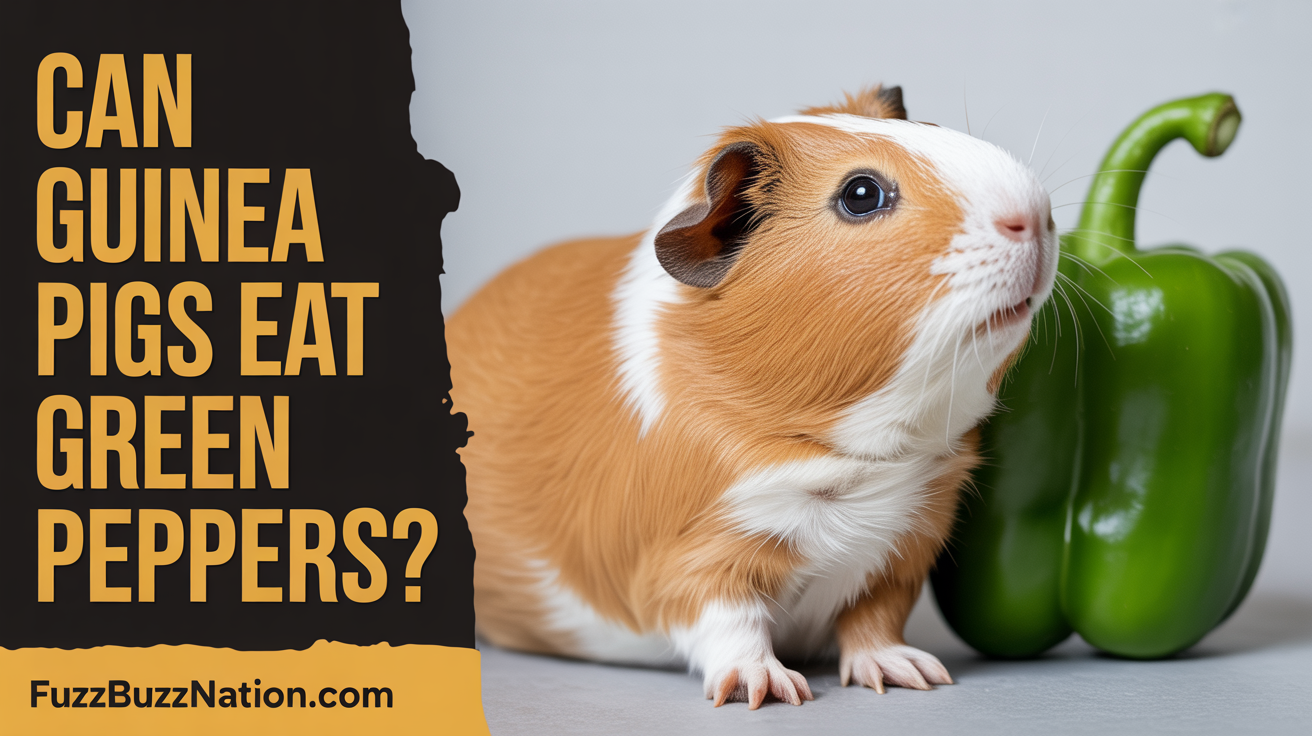
Can Guinea Pigs Eat Green Peppers? Daily Feeding Guide
After rescuing guinea pigs for eight years and watching countless cavies devour green peppers like candy, I can enthusiastically confirm that yes, guinea pigs can absolutely eat green peppers—and they should! Green bell peppers are one of the safest, most nutritious vegetables you can offer, providing exceptional vitamin C levels that rival even the famous orange.
My guinea pigs literally popcorn with excitement when they hear me chopping green peppers in the kitchen. Unlike some vegetables that require careful portion control, green peppers can be offered daily without concern for calcium buildup or digestive issues. In fact, they’re often the first vegetable I introduce to nervous rescue pigs because they’re so well-tolerated and universally loved.
Nutritional Benefits for Guinea Pigs
Exceptional Vitamin C Content
Green bell peppers contain approximately 80-120mg of vitamin C per 100 grams—nearly twice that of oranges! Since guinea pigs cannot produce their own vitamin C, this makes green peppers invaluable for preventing scurvy. One medium green pepper provides enough vitamin C for 2-3 guinea pigs’ daily requirements.
I’ve nursed several rescue guinea pigs through early-stage scurvy using green peppers as the primary vitamin C source. My rescue pig Oreo arrived with swollen joints and lethargy from vitamin C deficiency. Within two weeks of daily green pepper supplementation, he was running laps around his cage. The improvement was remarkable and faster than with vitamin C drops alone.
The vitamin C in green peppers remains stable longer than in many vegetables. While lettuce and cucumber lose vitamin C quickly after cutting, pepper pieces maintain their nutritional value for 24-48 hours when properly stored. This makes them perfect for meal prep or boarding situations.
Low Calcium and Sugar Advantages
Green peppers contain only 10mg of calcium per 100 grams—significantly lower than many popular guinea pig vegetables. This low calcium content means they’re safe for pigs prone to bladder stones or sludge. I feed green peppers daily to my senior pig with a history of bladder issues without any problems.
Sugar content in green peppers is also minimal compared to colorful bell peppers. Red peppers contain nearly twice the sugar of green ones. While all bell peppers are safe, green ones are ideal for overweight guinea pigs or those needing blood sugar management. My chunky rescue pig lost healthy weight when we switched from red to primarily green peppers.
Serving Size and Frequency
Daily Portion Guidelines
Through years of feeding various guinea pigs, I’ve found the optimal serving is 1/8 to 1/6 of a medium green pepper per pig daily—roughly 2-3 square inches or one thick ring. This amount provides substantial vitamin C without dominating their vegetable variety. Pregnant or nursing sows can have slightly more, up to 1/4 pepper daily.
I typically offer green pepper twice daily—a piece in the morning vegetable mix and another with evening vegetables. This split serving ensures consistent vitamin C intake throughout the day. Some owners worry about overfeeding, but I’ve never encountered issues from too much green pepper, unlike problems I’ve seen from excess carrots or fruit.
Best Preparation Methods
Always wash green peppers thoroughly under running water, even organic ones. I remove the stem, seeds, and white membrane—while not toxic, seeds can pose a choking hazard for enthusiastic eaters. The white ribs are safe but less palatable and often get left uneaten.
Cut peppers into strips about finger-width for easy handling. My guinea pigs enjoy holding strips like corn on the cob, nibbling from end to end. For elderly pigs with dental issues, I dice peppers into smaller pieces. Room temperature peppers are preferred over cold ones straight from the refrigerator—cold vegetables can cause temporary digestive discomfort.
Parts of the Pepper to Feed
Seeds and Membranes
While green pepper seeds aren’t toxic, I remove them for practical reasons. Seeds can get stuck in teeth or pose choking risks for fast eaters. Some guinea pigs actually enjoy playing with seeds more than eating them, creating unnecessary mess. The white membrane is nutritious but often ignored, so removal prevents waste.
One owner I know feeds seeds without issues, but her guinea pigs are notably calm eaters. My rescue pig Pepper (ironically named) once choked on a seed cluster, requiring intervention. Since then, I’ve been meticulous about seed removal. The thirty seconds spent deseeding prevents potential emergencies.
Skin and Flesh Preferences
The entire pepper flesh and skin are safe and nutritious. Some guinea pigs prefer the crunchy outer skin, while others favor the juicier inner flesh. My pig Pickles carefully eats all the inner flesh first, leaving paper-thin skin pieces. His cage mate Bruno does the opposite, peeling and eating skin first.
Young guinea pigs sometimes struggle with tough skin initially. If your pig leaves skin pieces, try peeling strips partially or scoring the skin. As their teeth strengthen, they’ll manage whole pieces better. Never remove skin entirely—it contains valuable fiber and nutrients.
Comparing Green to Other Bell Peppers
Color Variations and Benefits
All bell pepper colors are safe, but nutritional profiles differ. Red peppers contain the most vitamin C (190mg/100g) but also highest sugar. Yellow and orange fall between green and red for both vitamin C and sugar content. Green peppers offer the best balance for daily feeding—high vitamin C without excess sugar.
I rotate colors throughout the week: green peppers Monday/Wednesday/Friday/Sunday, red peppers Tuesday/Saturday, and yellow Thursday. This provides variety while maintaining green peppers as the staple. Cost also factors in—green peppers are typically cheapest, making them budget-friendly for multi-pig households.
Why Green Peppers Are Often Preferred
Beyond nutrition, green peppers have practical advantages. They last longer in the refrigerator (up to two weeks properly stored) compared to red or yellow peppers that spoil within a week. Green peppers are also more consistently available year-round and maintain steadier prices.
Interestingly, about 80% of my guinea pigs prefer green peppers over other colors when offered choices. The slightly bitter taste seems to appeal to their palates. Only my youngest pigs typically prefer sweeter red peppers, though most develop a preference for green as they mature.
Common Concerns and Solutions
Pesticide Residues
Conventionally grown peppers often appear on “high pesticide” produce lists. I always buy organic when possible, though cost can be prohibitive. For conventional peppers, wash thoroughly with water and a soft brush. Some sources recommend baking soda solutions, but thorough water rinsing removes most surface residues.
During summer, I grow my own peppers in containers—even apartment balconies can support 2-3 pepper plants. Home-grown peppers provide pesticide-free produce and engaging entertainment as guinea pigs watch “their” plants grow. One plant produces enough peppers for 1-2 guinea pigs through the growing season.
Storage and Freshness
Store whole peppers in the crisper drawer, unwashed until use. Once cut, wrap pieces in paper towels and place in airtight containers. Cut peppers last 3-4 days maximum. I prep 2-3 days’ worth during twice-weekly shopping to maintain freshness while saving daily prep time.
Never feed peppers with soft spots, mold, or wrinkled skin. While guinea pigs have robust digestive systems, spoiled vegetables can cause serious illness. When in doubt, compost it. The dollar saved isn’t worth potential veterinary bills or losing a beloved pet.
Introducing Green Peppers to Picky Eaters
Gradual Introduction Techniques
While most guinea pigs immediately love green peppers, some need encouragement. Start with tiny pieces mixed into accepted vegetables. Gradually increase pepper size while decreasing familiar vegetables. This transition typically takes 5-7 days for hesitant pigs.
My pickiest rescue took two weeks to accept green peppers. I started by rubbing pepper juice on his favorite cucumber slices, then added minuscule pepper pieces to his pellet bowl. Eventually, curiosity won and he tried a piece. Now he wheeks demanding peppers every morning!
Making Peppers More Appealing
Temperature matters—room temperature peppers are more aromatic and appealing than cold ones. Try different cuts: some pigs prefer matchsticks, others rings, some want chunks. My pig Theodore only eats peppers cut into perfect triangles—any other shape gets ignored until he’s desperately hungry.
Hand-feeding creates positive associations. Sit with your guinea pig, offering small pieces while talking softly. The bonding experience often overcomes food hesitation. Sometimes watching another pig enjoy peppers triggers interest—guinea pigs learn from observing cage mates.
Health Benefits Beyond Nutrition
Dental Health Support
The crunchy texture of green peppers helps wear down continuously growing teeth. While not replacing hay’s crucial dental benefits, peppers provide supplementary tooth wear. The gnawing action required for pepper strips exercises jaw muscles and promotes proper tooth alignment.
I’ve noticed guinea pigs who regularly eat crunchy vegetables like peppers have fewer dental issues than those eating primarily soft foods. My ten-year-old pig still has perfect teeth, which his vet attributes partially to his daily pepper consumption alongside unlimited hay.
Hydration Benefits
Green peppers contain approximately 92% water, providing hydration alongside nutrition. This benefits guinea pigs who drink minimally or during hot weather. Several of my rescue pigs arrived dehydrated and suspicious of water bottles. Green peppers helped maintain hydration while they learned to drink properly.
During summer, I increase pepper servings slightly to boost fluid intake. The water content in peppers is naturally balanced with electrolytes, making it superior to plain water for hydration. Never replace water bottles with vegetables, but use water-rich foods as supplementary hydration.
Frequently Asked Questions
Can baby guinea pigs eat green peppers? Yes! Guinea pigs can eat green peppers from 2-3 weeks old when they start solid foods. Begin with tiny pieces—about fingernail size—once daily. By eight weeks, they can have adult portions. Young pigs often prefer sweeter red peppers initially but usually develop green pepper preference with maturity.
Are hot peppers or chili peppers safe? Absolutely not! Only sweet bell peppers are safe for guinea pigs. Hot peppers, jalapeños, and any spicy varieties can cause severe digestive distress, mouth pain, and potentially dangerous inflammation. Stick exclusively to sweet bell peppers in any color—green, red, yellow, or orange.
Can guinea pigs eat cooked green peppers? While cooked peppers aren’t toxic, cooking destroys vitamin C and changes texture unpleasantly for guinea pigs. Always serve raw peppers to preserve nutritional value. Grilled, roasted, or sautéed peppers often have added oils or seasonings that can harm guinea pigs.
Why does my guinea pig’s urine look red after eating peppers? Green peppers shouldn’t cause red urine, but red bell peppers might cause slight orange tinting—this is harmless. However, actual red urine indicates blood and requires immediate veterinary attention. Don’t assume dietary causes for genuinely red urine.
How can I tell if a green pepper has gone bad? Fresh peppers are firm with glossy, unwrinkled skin. Spoiled peppers develop soft spots, wrinkled skin, mold (often near the stem), or slimy texture. Any off-odor indicates spoilage. When peppers feel lighter than usual, they’re dehydrating and past prime. Always err on the side of caution.
Incorporating Green Peppers into Daily Diet
Green peppers deserve their reputation as a guinea pig superfood. Their exceptional vitamin C content, low calcium levels, and high palatability make them ideal for daily feeding. Unlike many vegetables requiring moderation, green peppers can be offered generously without health concerns.
Start with proper introduction, maintain freshness through appropriate storage, and observe your guinea pig’s preferences for cut size and presentation. Most guinea pigs quickly become pepper enthusiasts, wheeking excitedly at the mere sound of pepper preparation.
Remember that while green peppers are nutritionally excellent, variety remains important. Combine them with other safe vegetables, quality pellets, and unlimited hay for complete nutrition. With green peppers as a dietary staple, you’re providing one of the best possible foods for your guinea pig’s health and happiness.


